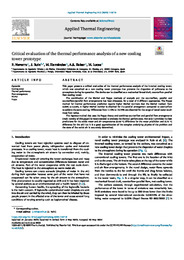Por favor, use este identificador para citar o enlazar este ítem:
https://hdl.handle.net/11000/35368Registro completo de metadatos
| Campo DC | Valor | Lengua/Idioma |
|---|---|---|
| dc.contributor.author | Navarro Cobacho, Pedro | - |
| dc.contributor.author | Ruiz Ramírez, Javier | - |
| dc.contributor.author | Hernández, Mónica | - |
| dc.contributor.author | Kaiser, Antonio S. | - |
| dc.contributor.author | Lucas Miralles, Manuel | - |
| dc.contributor.other | Departamentos de la UMH::Ingeniería Mecánica y Energía | es_ES |
| dc.date.accessioned | 2025-01-28T09:18:01Z | - |
| dc.date.available | 2025-01-28T09:18:01Z | - |
| dc.date.created | 2022 | - |
| dc.identifier.citation | Applied Thermal Engineering | es_ES |
| dc.identifier.issn | 1873-5606 | - |
| dc.identifier.issn | 1359-4311 | - |
| dc.identifier.uri | https://hdl.handle.net/11000/35368 | - |
| dc.description.abstract | This paper presents a critical evaluation of the thermal performance analysis of the inverted cooling tower, which was conceived as a new cooling tower prototype that prevents the dispersion of pollutants to the atmosphere during its operation. The device can be classified as a mechanical forced draft, counterflow-parallel flow cooling tower. The combination of the Merkel and Poppe methods of analysis and the counterflow, parallel and counterflow/parallel flow arrangements has been discussed, for a total of 5 different approaches. The Poppe method for thermal performance prediction reports higher Merkel numbers than the Merkel method: from 3.84% to 6.64%. A higher Merkel number is obtained for the parallel arrangement compared to counterflow to achieve the same cooling. Differences from 1.12% to 12.19% are observed for the range of tested water-to-air mass flow ratios. The rigorous method that uses the Poppe theory and combines counterflow and parallel flow arrangements (main novelty of this paper) is recommended to evaluate the thermal performance. Not only it provides the best predictions for the outlet water and air temperatures (0.44 °C difference for the water prediction and 0.74 °C difference for the air) but it is a good approximation of the complex underlying physics of the problem and the state of the outlet air is accurately determined. | es_ES |
| dc.format | application/pdf | es_ES |
| dc.format.extent | 12 | es_ES |
| dc.language.iso | eng | es_ES |
| dc.publisher | Elsevier | es_ES |
| dc.relation.ispartofseries | 213 | es_ES |
| dc.rights | info:eu-repo/semantics/openAccess | es_ES |
| dc.rights.uri | http://creativecommons.org/licenses/by-nc-nd/4.0/ | * |
| dc.subject | Cooling tower | es_ES |
| dc.subject | Thermal performance | es_ES |
| dc.subject | Flow arrangement | es_ES |
| dc.subject | Merkel | es_ES |
| dc.subject | Poppe | es_ES |
| dc.subject.other | CDU::6 - Ciencias aplicadas::62 - Ingeniería. Tecnología::621 - Ingeniería mecánica en general. Tecnología nuclear. Electrotecnia. Maquinaria | es_ES |
| dc.title | Critical evaluation of the thermal performance analysis of a new cooling tower prototype | es_ES |
| dc.type | info:eu-repo/semantics/article | es_ES |
| dc.relation.publisherversion | https://doi.org/10.1016/j.applthermaleng.2022.118719 | es_ES |

Ver/Abrir:
2022 ATE 213.pdf
2,02 MB
Adobe PDF
Compartir:
 La licencia se describe como: Atribución-NonComercial-NoDerivada 4.0 Internacional.
La licencia se describe como: Atribución-NonComercial-NoDerivada 4.0 Internacional.
.png)